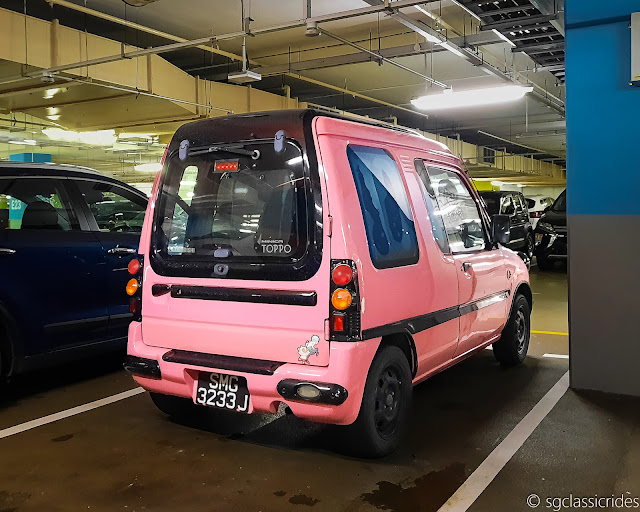It never fails to put a smile on my face when I write about relatively obscure models here, regardless if it is not eye-catching. Having seen this 1972 Rover P5B Coupe a few times, I was glad to be able to go up close finally and admire how it stood out from the usual classics here!
Designed by David Bache since the early 1950s, the P5 was envisaged as a 'light P4' with a 'floor-cum-chassis' construction. It was Rover's first attempt at a monocoque design, and there were many variations put forth on the drawing board such as rear engines, gearbox mounted under the seat and various configurations of V6 engines for the car. Unveiled at the Earls Court Motor Show in 1958, it was well received although there were criticisms of sub-standard noise suppression and heavy steering. The cabin was one of the P5’s greatest assets: it blended modern ergonomics with traditional mahogany and leather that would not have looked out of place in a top London club.
While the P5 sold well to the older driver, Rover was keen to distance itself from this gentlemanly image and constantly modernised it throughout its existence. The Mark II version for the P5 was introduced in 1962, and notably featured the addition of the 4-door coupe: the roofline was lowered by 2.5 inches along with thinner B-pillars, with Hydrosteer power steering fitted as standard on the coupe. The Mark III, introduced in 1965, had a more powerful engine and the rear bench seat was replaced with two individually moulded rear seats.
The final iteration of the P5, known as the P5B, was released in 1967. Rover discovered that the Buick V8 engine was well-fitted for the car, and thus campaigned for General Motors to release the tooling. With the lighter engine, the P5B had better handling: reviews praised its superb insulation and good fuel economy. It was distinguished from earlier models with built-in foglights and chromed Rostyle sheels. The P5B was powered by a 3528 cc Rover V8 engine, allowing it to reach a top speed of 185 km/h with an accelaration of 12.1 seconds [0-100 km/h]. It had dimensions of 4750 x 1781 x 1473 mm and weighed in at 1625 kg, with a fuel consumption of 16.1 litres / 100 km.
Saloon version of the P5B: note the differences in the windows and body style with the coupe.
The P5B was noted to be the British Mercedes and was a favourite with government officials: the late Queen Elizabeth II owned a few units in a special dark green colour and the last batch of P5Bs were reserved for government used when required. However, Rover went into a decline after their merger with Leyland and BMC, and the super-company had too many competing brands and priorities for Rover to get the investment that they needed to flourish.
Production of the P5B ended in 1973, with 9,099 coupes (split between 8,697 RHD and 402 LHD) and 11,501 saloons made. The first-generation Rover P5s were sold here in 1959 by Champion Motors Ltd, though P5Bs did not appear to be officially brought in. However, a few units did exist up till the early 1980s based on newspaper ads. This unit was imported from the UK a few years ago and was subject to an extensive restoration, where it was formerly grey.
Coupes are noted to be more desirable and tend to be sold a few thousand pounds in the market. As 1 of about 13 Rover cars in Singapore, you would be forgiven for not knowing about its existence. The fact that someone found it interesting enough to import this curiosity here is wonderful in itself: makes you wonder what was going through the owner's mind? Hopefully, this post has been a good introduction to this rarity and perhaps you will be able to see it on the roads!









